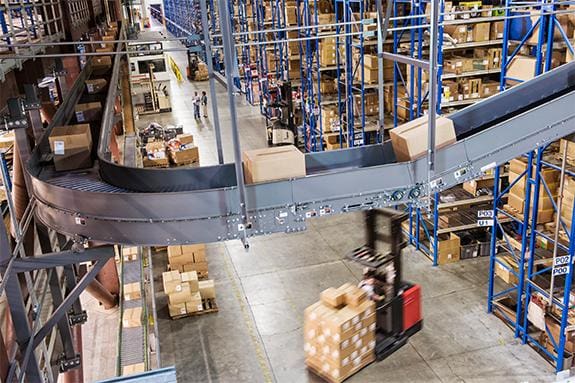Inventory management is like walking an endless tightrope, constantly navigating the delicate balance between having too much and too little stock. To succeed, companies need to wrangle complex supply chains, accurately forecast demand, and manage fast-moving warehouse operations. If it sounds overwhelming, that’s because it often is—and the stakes are high. Too much inventory ties up valuable capital and space, while shortages, known as stockouts, can lead to lost sales and unhappy customers. Globally, 8% of inventory perishes or is discarded annually at a cost of $163 billion, according to one recent study.
Automated inventory management offers a lifeline, providing surer footing and a more navigable path. Advanced inventory systems streamline inventory tracking, dramatically improve accuracy, and provide the firepower that allows companies to respond swiftly to market changes based on deeper insights into consumer behavior and trends. This article explores how automated inventory management systems work, their key features and benefits, and the latest emerging trends.
What Is Automated Inventory Management?
Inventory can take several forms, including raw materials, works-in-progress, finished goods, or even consumables such as food and supplies. Managing inventory can be extremely challenging, especially as companies grow, because of issues such as overstocking (having excess inventory that ties up capital), understocking (running out of stock and potentially losing sales) and human error, such as mistakes in tracking or ordering inventory. These challenges can lead to lost sales, excess carrying costs and pricey inefficiencies. Automated inventory management is the process of using technology to track, control, and optimize stock levels without the need for manual intervention. It addresses the aforementioned challenges by using tools, such as barcode scanners and radio frequency identification (RFID) tags, that are attached to products and packaging and store information that can be scanned to track inventory movement.
Automated inventory management also incorporates business software, such as enterprise resource planning (ERP) systems, warehouse management systems (WMS), and inventory management tools, to manage inventory more effectively. These technologies monitor inventory in real time, simplifying and streamlining the reordering processes and reducing errors. For example, an automated inventory system can alert managers when stock is low, automatically reorder items, and provide detailed analytics on inventory trends. This saves time and helps maintain optimal stock levels, keeping customers happy and improving cash flow.
Key Takeaways
- Managing inventory requires effective supply chain management, demand forecasting, and coordination of fast-moving warehouse operations, among other important tasks.
- Automated inventory management systems track, control, and optimize stock levels without the need for manual intervention.
- The benefits of automated inventory management systems include time savings, improved accuracy, and greater inventory visibility to drive smarter decisions.
- Companies considering automated inventory systems should look for several key features, such as multilocation inventory tracking, barcode scanning, and ecommerce integration.
- Emerging technologies, such as automated replenishment, robotics, the Internet of Things (IoT), cloud-based solutions, and blockchain, are expected to have a major impact on automated inventory systems.
Automated Inventory Management Explained
The concept of inventory has different meanings in different industries. In manufacturing, inventory often takes the form of raw materials and products in various stages of completion. In hospitality, inventory can refer to hotel room availability. Despite the differences, almost all industries use automated inventory management systems. In retail, for example, these systems help prevent overstocking or understocking by predicting demand and automating reorders. Manufacturers, meanwhile, integrate automated inventory management tools with production schedules to create seamless production flows and provide timely deliveries. Restaurants use these tools to monitor inventory in real time to reduce waste by tracking expiration dates and optimizing menu planning based on available stock. Automated inventory management systems also benefit healthcare facilities by maintaining accurate records of medical supplies and pharmaceuticals to reduce the risk of costly shortages of critical items and maintain regulatory compliance.
How Does an Automated Inventory Management System Work?
An automated inventory management system has several key components. At the heart of many systems are barcode scanners and RFID tags, which provide real-time data on product movement and stock levels. This data typically feeds into a central software platform, such as an inventory management system, ERP system, or WMS, which acts as the brain of the operation and offers a comprehensive view of inventory across multiple locations. These systems can use the data they track to forecast demand, manage reordering, and allocate stock efficiently. For example, if a retailer’s inventory management system detects a surge in demand for a particular product, it can automatically reorder more stock to prevent shortages.
Automated inventory management tools often include alerts for low stock levels or potential discrepancies, removing humans from the process and minimizing errors. A manufacturer, for example, can use the system to track raw materials from procurement to production, making sure all components are available when needed and avoiding costly production delays. When these components work in harmony, the result is a reduction in excess inventory, fewer stockouts, and valuable insights into inventory trends.
Key Benefits of Investing in an Automated Inventory Management System
Removing humans from complex and time-consuming tasks almost always results in improvements in process efficiency and accuracy. Automated inventory systems also offer a host of other critical benefits, including the following:
-
Time savings. Manually tracking orders, counting stock, and reordering can eat up employees’ time while also being costly. But with automated inventory management systems, employees can get real-time data updates to speed up decision-making and save time. For example, a retailer can automate the restocking process based on set thresholds, freeing staff to focus on customer service and other value-added activities. This not only cuts down on administrative tasks but also allows businesses to respond faster to shifting market demands.
-
Enhanced visibility. A key advantage of automated inventory management systems is that they provide a clear, real-time view of inventory across all locations, which makes it easier to track stock levels and movements. This helps companies quickly identify trends, manage stock levels, and make informed decisions. For example, if a distribution center can instantly see which items are running low and need restocking, it can reduce the risk of stockouts and promote better planning and forecasting.
-
Elimination of stock-level miscalculations. Automated systems use barcode scanning, RFID tags, and other technologies to update stock levels instantly, reducing the risk of human error in tracking stock levels. For instance, a warehouse that uses automated tracking can immediately record the addition or removal of items, keeping the inventory count precise. As a result, overstocking or stockouts are less likely.
-
Increased accuracy. By automating manual data entry and continuously updating inventory levels, advanced inventory management systems increase the accuracy of stock records. A grocery store, for example, can use automated systems to track every item scanned at checkout so its inventory count always reflects the actual stock. This accuracy helps store management make better purchasing decisions, reducing waste and optimizing inventory levels.
-
Better scalability. An automated inventory management system’s real-time data and analytics can help businesses manage inventory and new locations without overwhelming manual processes. For example, an ecommerce retailer expanding to multiple warehouses can easily track stock across sites, avoiding stockouts and overstock situations. This capability enables companies to grow quickly and efficiently while also maintaining consistency and accuracy as they scale.
-
Enhanced efficiency. Whenever companies are able to automate repetitive tasks and reduce manual errors, increased efficiency is almost surely to follow. Automated inventory tracking and real-time updates, for instance, help warehouses process orders faster, reducing time spent locating items and managing stock levels. A retailer can quickly adjust inventory based on sales data to optimize stock turnover and reduce excess inventory, saving time and improving overall productivity.
-
Improved decision-making. Access to real-time data in an automated inventory management system allows businesses to make informed decisions about inventory levels, purchasing, and sales strategies. A retailer, for example, can analyze trends from automated reports to identify best-selling items and adjust its ordering accordingly. This data-driven approach reduces the guesswork often involved in inventory management, leading to fewer overstocks or stockouts and the ability to respond quickly to market fluctuations.
Beneficiaries of an Automated Inventory Management System
Warehouse personnel would seem to be an obvious beneficiary of automated inventory systems, but they’re not the only ones who benefit. The following groups are likely to realize significant advantages.
-
Customer service teams: Customer service employees can benefit tremendously from accurate inventory data, which allows them to provide precise information about product availability, particularly if inventory systems are integrated with a customer relationship management (CRM) tool. In that scenario, when a customer asks about an item’s status, a customer service representative can instantly check the system to confirm whether it’s in stock and provide an accurate delivery estimate. This enhances customer satisfaction and builds trust and loyalty.
-
Warehouse staff: With automated systems, warehouse teams can benefit from streamlined inventory processes that reduce manual tasks and errors. For example, barcode scanning and automated data entry can help warehouse workers locate and pick items more quickly, thereby reducing search time and increasing productivity. Improved inventory accuracy from automated systems also allows staff to focus on high-value tasks, such as quality control and warehouse optimization, rather than conducting frequent manual counts.
-
Suppliers: The increased inventory visibility companies get from automated systems can also extend to their suppliers, allowing them to better forecast demand and plan production. For instance, when a retailer shares real-time inventory data with suppliers, the suppliers can adjust their manufacturing schedules to meet actual needs, reducing overproduction and waste. This transparency also helps maintain a flexible and effective supply chain because suppliers can anticipate and respond to orders more efficiently. Additionally, greater collaboration builds stronger relationships and more reliable supply networks.
-
Food and beverage companies: Food and beverage companies are unique in that their inventories are perishable. Automated systems make it much easier for them to track and restock items in a more accurate and timely fashion. A bakery, for instance, can use real-time data to monitor ingredient levels so fresh supplies are ordered before stock runs low. This helps prevent spoilage and waste by optimizing inventory turnover rates. Automated inventory systems also support compliance with health and safety regulations by maintaining accurate records of product shelf life and batch tracking.
-
Healthcare providers: Healthcare inventories are critical because running out of essential healthcare supplies can literally cost lives. Precise inventory tracking from automated systems can make a huge difference. For example, a hospital can monitor the use of essential medications and reorder them before they run out, which reduces the risk of shortages and helps maintain compliance with regulations for medication management. Accurate inventory records also support better financial management by minimizing waste and optimizing stock levels.
-
Retailers: Retailers manage dynamic and diverse inventories, requiring quick reflexes to adapt to changing consumer demands and trends. With automated systems, clothing stores, for example, can track which styles are selling fastest and reorder popular sizes before they run out, which minimizes overstock and maximizes every sales opportunity. This real-time insight also helps retailers optimize shelf space and balance inventory to match seasonal variations. Accurate data also supports better promotions and pricing strategies because retailers can clear out slow-moving items more effectively.
-
Manufacturers: Manufacturers manage complex inventories, including raw materials, components, and finished goods, which requires precise coordination to maintain efficient production schedules. Consider a car manufacturer, which can use automated inventory systems to accurately track parts to synchronize assembly lines and prevent delays. Real-time data on stock levels allows manufacturers to optimize ordering and reduce the risk of production stoppages due to shortages. It also cuts costs and enhances product quality by making sure the right materials are always available when needed.
10 Essential Features to Consider in an Automated Inventory Management System
Choosing the right automated inventory management system requires careful planning, vetting, and project management. While each company’s needs are different, the following capabilities can be considered core components of an effective solution.
-
Multilocation tracking: Managing inventory across multiple warehouses, stores, or other locations that hold stock presents challenges, such as balancing stock levels and coordinating shipments. Multilocation tracking automates the monitoring and transfer of inventory across locations, continuously updating inventory data in real time and alerting managers to discrepancies and low stock levels. For example, when a warehouse’s stock dips below a certain threshold, the system can automatically trigger a transfer order from another location with excess inventory. This reduces manual intervention, speeds up the redistribution process, and helps maintain ideal stock levels across warehouses.
-
Barcode scanning: Barcode scanning technology uses scanning devices to read barcodes on products and instantly update inventory levels in an inventory system. Barcodes are widely used for their simplicity and low cost, making them popular in retail and small businesses. Here’s how barcode scanning works: When a product is received or sold, the barcode is scanned and the system automatically adjusts the stock count. This reduces human error, speeds up inventory processes, and provides real-time visibility into stock levels, making it easier to manage and optimize inventory across different locations.
-
RFID: Whereas barcode scanning technology is used to scan and read information directly from a product or box, RFID technology enables the tracking of items without line-of-sight scanning, which is crucial for efficient stock control in large warehouses. RFID tags are placed on items, which are then read by RFID readers or scanners to track and manage inventory efficiently. For instance, a warehouse might place RFID portals at dock doors to automate inventory tracking during receiving, picking, and shipping. These RFID portals read RFID-tagged items as they pass through, allowing for real-time tracking and verification of stock levels. The result is better inventory accuracy, faster restocking, and valuable insights into product movement and sales trends.
-
Automatic reorders: Keeping shelves full without overstocking or understocking is a constant challenge, especially in industries with high demand variability, such as retail fashion. Automatic reordering tracks inventory levels and triggers reorders when stock falls below a certain threshold set by the company. In a retail fashion store, for example, automatic reordering can replenish trending clothing items before they sell out, helping the store stay responsive to changing customer preferences. Automatic reordering also removes the need for manual oversight, improves stock availability, and promotes greater efficiency.
-
Seamless ecommerce integration: The popularity of ecommerce poses distinct inventory challenges, such as synchronizing stock levels across multiple sales channels and providing accurate availability updates to customers. Seamless integration can connect online platforms with inventory systems to update stock levels in real time as products are sold or restocked. This is crucial for customers, who need to see accurate product availability. For businesses, it reduces the risk of overselling and backorders. An online clothing retailer, for example, can automatically update its website to reflect current stock levels so customers don’t order out-of-stock items.
-
Inventory forecasting: Inventory management requires precise planning to balance stock availability with fluctuating demand. Inventory forecasting uses automated data analysis to predict future stock needs by leveraging algorithms to analyze historical sales data, seasonal trends, and market conditions and provide accurate demand projections. For instance, an automated system in a toy store can forecast increased demand for specific toys during the holiday season and automatically adjust reorder points and quantities. This helps prevent overstocking and stockouts, optimizes inventory levels, and reduces costs.
-
Multiuser access: Coordination among various departments, such as purchasing, sales, and warehousing, is essential for smooth inventory operations. Multiuser access allows team members from different departments to work within the system simultaneously, with all updates reflected in real time, which maintains accuracy and prevents data silos. For example, if a sales team member is logging a large order at the same time a purchasing team member is updating stock levels, the system automatically synchronizes the information. The sales entry adjusts the inventory count immediately, and any stock shortages are simultaneously flagged for the purchasing team, even as they input their own updates. This leads to better communication and collaboration and reduces the risk of errors.
-
Synchronization across sales channels: Inventory management in today’s multichannel retail environment demands real-time synchronization to maintain accurate stock levels and avoid discrepancies. Synchronization across sales channels allows companies to update inventory data simultaneously across all platforms, such as online stores, brick-and-mortar shops, and third-party marketplaces. For instance, if a product is sold in a store, an inventory management system automatically updates the online inventory to reflect the change, preventing overselling and stockouts.
-
Automatic stock transfers: Balancing stock levels across multiple locations is essential to meeting customer demand and optimizing resources. Automatic stock transfers create a seamless movement of inventory among warehouses or stores based on real-time data. Companies set predefined rules or triggers, such as low stock levels at one location, that prompt an automatic transfer from another location with surplus stock. So a retail chain could automatically redistribute seasonal clothing items from stores with excess inventory to those experiencing higher demand, achieving the dual goals of reducing stockouts and extra stock.
-
Automated order management: When it comes to meeting customer expectations and maintaining smooth operations, handling orders efficiently is paramount. Automated order management makes this possible by streamlining the order processing workflow, reducing manual errors, and speeding up the fulfillment process. It allows companies to automatically receive, process, and update orders as they come in, coordinating with inventory data to keep stock levels accurate. For example, an ecommerce business can use automated order management to instantly process orders from its website, update inventory counts, and generate packing slips without manual intervention.
Emerging Trends in Inventory Management Automation
The following capabilities aren’t all standard components of automated inventory management systems, but they’re becoming increasingly popular. It would be wise to ask potential vendors about their plans for each.
-
Artificial intelligence (AI): As with most technologies, AI is having a profound impact on inventory management software. Companies can leverage predictive analytics to help forecast demand more accurately, thereby optimizing stock levels and reducing waste. AI can also automate reorder processes and adjust based on real-time sales data and trends, which helps prevent stockouts and overstocking. Another potential advantage of AI is greater supply chain efficiency, whereby AI identifies patterns and inefficiencies that improve decision-making. Finally, AI can help improve inventory accuracy by integrating with IoT devices for real-time tracking and monitoring, which allows the technology to help predict demand, optimize reordering processes, and detect potential issues before they arise.
-
Automated replenishment: Inventory management is a constant battle to avoid overstocking or running out of products. Automated replenishment helps maintain ideal inventory levels by automatically reordering products as they reach a predetermined threshold. Whereas automatic reordering (discussed above) is based on thresholds set by the company, automated replenishment uses data on sales patterns and inventory turnover to predict when stock needs replenishment. A grocery store, for instance, can automatically reorder fresh produce based on historical sales data so shelves are consistently stocked with fresh items. The result is lower holding costs and a steady flow of goods.
-
Sustainability initiatives: In inventory management, reducing waste and optimizing resources are key. Sustainability initiatives to minimize excess inventory, use eco-friendly packaging, and optimize delivery routes can help reduce carbon footprints. A retailer, for example, may already be using an automated inventory management system to forecast demand more accurately, reducing the risk of overstocking and waste. This system can also help streamline the ordering process by sourcing materials from local suppliers to cut down on transportation emissions. This approach benefits the environment and enhances operational efficiency.
-
Robotics and automation: Inventory management often requires precise and repetitive tasks, making robotics and automation invaluable for efficiency and accuracy. These technologies can streamline operations by automating tasks, including sorting, picking, and packing, thereby reducing human error and increasing speed. For example, in a warehouse setting, robotic arms can pick items from shelves and pack them for shipping using real-time data and machine learning algorithms. In addition to speeding up the fulfillment process, this leads to cost savings and improved productivity.
-
IoT integration: Keeping track of assets in real time across multiple locations can be daunting. IoT integration helps solve this by using internet-connected devices to monitor and manage inventory items, providing real-time data and analytics. For example, smart shelves equipped with IoT sensors can detect when stock levels are low and automatically trigger a reorder. Integrating IoT technologies and inventory management systems helps businesses maintain ideal inventory levels, reduce waste, and improve the accuracy of inventory tracking, all while providing valuable insights into usage patterns and supply chain efficiencies.
-
Cloud-based solutions: Accessing data anytime, anywhere, and ensuring it’s up-to-date and synchronized across all locations is key to effective inventory management. Cloud-based solutions offer flexibility by hosting inventory data on remote servers, allowing users to access real-time information through the internet. This creates seamless data sharing and integration across multiple departments and locations and makes it easier to manage inventory in a unified way. For instance, a global retailer can use a cloud-based inventory system to track stock levels in different countries, automatically updating central databases to reflect sales and inventory movements. It’s not only more accurate, but it improves scalability and agility as well.
-
Blockchain for supply transparency: Inventory management processes often struggle to build transparency and traceability in the supply chain, which is where blockchain technology comes in. Blockchain technology creates a secure record of every transaction and movement within the supply chain and makes it accessible to all authorized parties. As a result, companies can verify the authenticity and origin of products—especially useful in industries such as pharmaceuticals and food, where quality and compliance are crucial. A luxury goods retailer could also use blockchain to provide customers with a complete history of an item, from manufacturing to the end consumer, ensuring authenticity and building trust.
Streamline Automated Inventory Management with NetSuite Inventory Management
NetSuite Inventory Management gives companies the tools needed to improve their operations and enhance efficiency, including real-time visibility, automated order management, and demand planning. This automated inventory management solution in NetSuite ERP helps optimize stock levels, reduce manual errors, and improve overall supply chain accuracy, allowing customers to monitor stock levels across multiple locations, replenish stock quickly, and avoid stockouts.
Inventory management is just one component of NetSuite’s broader cloud-based product portfolio, which includes seamlessly integrated finance, CRM, ecommerce, human resources, and manufacturing modules as part of its unified ERP platform. This integrated approach creates seamless data flow across departments to improve decision-making and operational efficiency. Because its solutions are cloud-based, NetSuite provides effortless scalability to quickly add capabilities, and computing power to support company growth and adapt to changing needs.
Managing inventory effectively can be complex and challenging, requiring careful balance and quick adjustments. Automated inventory management systems offer businesses the precision and agility necessary to streamline operations, reduce costs, and build stronger customer relationships. For the best chance of success, look for scalable systems that offer many of the capabilities listed above and that integrate well with existing systems.
Automated Inventory Management FAQs
What is an automated inventory management system?
An automated inventory management system uses technology to track, control, and optimize inventory levels without manual intervention. It integrates tools, including barcode scanners, radio frequency identification (RFID) tags, and inventory management software, to monitor stock in real time. By automating reordering and providing accurate inventory data, an automated inventory management system helps businesses avoid overstocking and stockouts, which in turn enhances efficiency, reduces errors, and improves decision-making across the supply chain.
What are the four types of inventory management systems?
The four types of inventory management systems are just-in-time (JIT), material requirements planning (MRP), economic order quantity (EOQ), and ABC analysis. JIT focuses on receiving goods only when they’re needed, reducing holding costs. MRP uses forecasts and production schedules to determine material requirements to meet demand. EOQ calculates the optimal order size to minimize costs. ABC analysis categorizes inventory based on importance and value, allowing for prioritized management.
How should companies use AI for inventory management?
Companies can use artificial intelligence (AI) to assist with inventory management by leveraging predictive analytics to forecast demand more accurately, thereby optimizing stock levels and reducing waste. AI can also automate reorder processes and adjust for real-time sales data and trends, which prevents stockouts and excess inventory.
When would a company use an automated inventory control system?
A company would use an automated inventory control system to streamline inventory tracking, reduce manual errors, and optimize stock levels. It’s particularly useful for businesses with high sales volume, multiple locations, or complex supply chains. This type of system is also beneficial when accurate, real-time inventory data is crucial for decision-making, such as in ecommerce or retail environments. Additionally, companies facing challenges such as stockouts or overstocking can use these systems to enhance efficiency and reduce costs.








